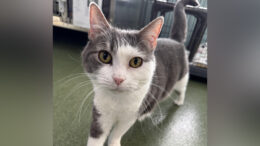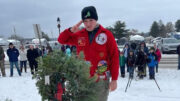Peas (Pisum sativum) are a cool season crop. If you ask a gardener if she or he grows peas, the answer is generally, “yes.” Because peas can germinate in cool soil, many gardeners are happy to grow peas because they can resume their gardening earlier in the spring. A more pointed question to a gardener may be the types of peas they grow. The response to this question may lead to a discussion about the somewhat confusing naming of peas.
Within Pisum sativum, there are three types of peas: English peas, snow peas and sugar snap peas. Each of these types of peas may be known by multiple names. While a rose may still be a rose, a pea is not always a pea.
In addition to interchangeable names of Pisum sativum, some plants called peas, are, from a botanical perspective, not peas. Black-eyed peas are an excellent example. Black-eyed peas (Vigna unguiculata) are a variety of the cowpea and part of the Legume family. Although called a pea, it is actually a bean and a good example of confusing vegetable names. Both peas and beans are legumes and both have edible seeds and pods.
According to the Penguin Companion to Food, bean is a “term loosely applied to any legume whose seeds or pods are eaten, not classed separately as a pea or lentil.” Beans traditionally were in the genus Phaseolus, but now some of the species, including the black-eyed pea, are in the genus Vigna. Peas are in the genus Pisum.
Gregor Mendel’s Pea Experiments
Gregor Mendel conducted a series of experiments using Pisum sativum. Mendel, born in 1822, grew up on a farm in Austria, studied math and science at the University of Vienna, and then became a monk. In the mid-1800s, he conducted a number of experiments using garden peas at the monastery where he lived. He selected peas for his experiments because they were easy to grow and he could grow multiple crops in one season. His research produced the Mendel Laws of Inheritance: The Law of Dominance, The Law of Segregation, and The Law of Independent Assortment. This was groundbreaking scientific work. His laws also apply to human genetics.
Types of Peas
Shelling peas, sugar snap peas, and snow peas are the results of breeding for specific characteristics. All may be eaten out-of-hand whilst walking through the garden! Shelling peas are also known as English peas or garden peas. As the name implies, these peas are removed from the pod before consuming fresh from the garden, cooking for dinner, or freezing for later enjoyment. In order to remove the peas, gently pull the string beginning at the stem end. The pod will open, revealing the peas inside, much as a string bean does. Shell pea pods range in length from 3 to 4 inches and are round and firm.
Snow peas are conventionally known only as “snow peas” and may be eaten with or without the string. These peas are harvested when quite young while the pod is still tender to the touch, and from 2 to 3 inches long. The pods and peas are flat. Snow peas are frequently included in Asian recipes.
Snap peas are also referred to as sugar snap peas. Ideally, sugar snaps should be eaten raw, pod and all. The ideal sugar snap pea will be crispy and sweet. It may be harvested at “bite-size”. If the peas stay on the vine past the bite-size stage, remove the pods then sauté or steam them to enhance the texture. Sugar snap peas are a hybrid, bred using Mendel’s Laws of Inheritance.
Growing Peas
Peas may be successfully grown, keeping in mind the following cultural recommendations. It is a good idea to consult growing directions included on either the seed packet or in seed catalog for the specific pea you are growing. There may be differences in spacing, need for support, days to maturity, and succession planting.
General growing instructions include the following:
1. Soil should be well-drained with a pH of between 5.8 and 7.0.
2. Seeds (without soaking) will germinate between 6 and 17 days. Soaking the seeds overnight, but not more than 24 hours, will reduce the germination time.
3. Germination temperature may range from 40 to 85°F.
4. For a spring crop, direct sow in April. A fall crop may be planted in August. Check your growing zone temperature and seed-specific instructions.
5. Plant seeds from 11⁄2 to 3 inches apart in the row, 1 to 2 inches deep, and allow 18 to 30 inches between the rows. Consult the growing directions for the specific cultivar.
6. Keep plants turgid by supplying water at the rate of about 1 inch per week if rain is not sufficient. Applying water to the soil rather than from above may reduce the risk of disease.
For plants requiring support, stakes (metal, plastic, bamboo, or the like) should be placed in the soil, about 3 inches from the seed at the time of planting. Inserting the support while the plants are actively growing may damage the roots. In addition to providing support for the developing plants, the resulting vertical growth will help to increase the airflow around the plants. Increased airflow around the plants may help reduce the incidence of disease and/or insect damage. Peas may also be grown using the foot-by-foot, or square foot, method. Each 12 X 12-inch area can accommodate up to eight plants. Plants may be side dressed with compost when flowering begins.
Days to harvest for most peas is between 50 to 70 days. Check the growing instructions for details. For a steady supply of peas, sow new seeds every two to four weeks. When the plant turns yellow, it’s time for it to go. If the plant is free of insect and/or disease pests, the plant may be cut down at ground level. Leave the roots in the ground. Peas, like other legumes, fix nitrogen from the air and store it in their roots. Leaving the roots in the ground will keep that valuable fertilizer there, making it available for the next crop. The leaves and stems may be composted, but take care not include any part of a diseased plant in the compost. Diseased or damaged plants should be placed in the trash or burned.
Insects and Diseases
Peas are relatively free from pests. However, common insect pests may include cutworms, armyworms, leafhoppers, aphids, mites, and pea weevils. Many of these insects can be slowed by placing collars made from plastic, foil and/or cardboard around the pea seedlings. If the insect cannot reach the stem, it is less likely to harm the plant. Insects may be hand-picked from the plants and/or the plants may be treated by synthetic (Sevin) or organic pesticides, such as bacillus thuringiensis or Bt, labeled for use on peas. Be sure to read and follow label directions when treating a plant with a pesticide.
The two primary diseases found in peas are powdery mildew and damping off. To control powdery mildew on peas, apply neem oil to the foliage. However, do not apply neem oil to peas if the temperature is above 90°F. Alternatively, the foliage may be sprayed with a commercial fungicide labeled for treating powdery mildew on peas. Always follow label directions when applying any type of synthetic or dwarf organic pest control.
Damping off is caused by a fungus and may grow on seedlings growing in cold and wet soil. Once the plant shows signs and symptoms, it is generally too late. If you dig up the roots, they will likely be black. Seeds pretreated with a fungicide may reduce the likelihood of this fungus. Seed packets and seed catalog descriptions will disclose if seeds have been treated.
Suggested pea cultivars include:
Snow Peas
Oregon Giant – 5-inch flat pods, 30-inch vines should be trellised
Snow Sweet – large pods remain tender and sweet
Oregon Sugar Pod II – deer resistant, dwarf habit with 4 to 5-inch pods
Dwarf Grey Sugar – purple flowers, fast maturing with 2 to 3-inch pods
Sugar Snap Peas
Sugar Heart – heat tolerant, good disease resistance, 48-inch vines
Not all peas are green. There are a few yellow pea cultivars. See if you can find some and try growing them. A garden is the perfect place to experiment growing different plants, as Mendel did. Your results needn’t be for science, but rather to determine which varieties you and your family enjoy the most!
This educational blog is a series of informative articles from the Penn State Master Gardeners volunteers plus news concerning the group and their activities. For more information, click here.
































